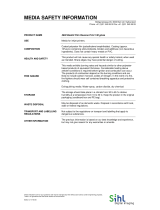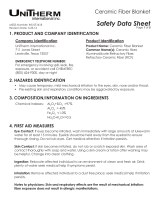Page is loading ...

Whiteboard renew
Safety Data Sheet
Prepared according to Federal Register / Vol. 77, No. 58 / Monday, March 26, 2012 / Rules and Regulations
Date of issue: 05/22/2018 Supersedes: 1.0 Version: 1.1
03/14/2018
Whiteboard renew
Page 1
SECTION 1: Identification of the substance/mixture and of the company/undertaking
1.1. Product identifier
Product name
:
Whiteboard renew
Product form
:
Mixture
1.2. Relevant identified uses of the substance or mixture and uses advised against
1.3. Details of the supplier of the safety data sheet
Talk About It Solutions
8401 Jefferson HWY
Maple Grove, MN 55369
Phone: 1-833-736-6683
1.4. Emergency telephone number
CHEMTREC: 1-800-424-9300
SECTION 2: Hazards identification
2.1. Classification of the substance or mixture
GHS-US classification
Not classified
2.2. Label elements
GHS-US labelling
No labelling applicable
2.3. Other hazards
No additional information available
2.4. Unknown acute toxicity (GHS US)
No data available
SECTION 3 : Composition/information on ingredients
3.1. Substances
Not applicable
3.2. Mixtures
Name
Product identifier
%
Contains no hazardous ingredients at levels requiring disclosure by the OSHA Hazard Communication Standard (29 CFR
1910.1200)
SECTION 4: First aid measures
4.1. Description of first aid measures
First-aid measures general
:
If exposed or concerned, get medical attention/advice. Show this safety data sheet to the
doctor in attendance. Wash contaminated clothing before re-use. Never give anything to an
unconscious person.
First-aid measures after inhalation
:
IF INHALED: Remove to fresh air and keep at rest in a comfortable position for breathing.
First-aid measures after skin contact
:
IF ON SKIN (or clothing): Remove affected clothing and wash all exposed skin with water for at
least 15 minutes.
First-aid measures after eye contact
:
IF IN EYES: Immediately flush with plenty of water for at least 15 minutes. Remove contact
lenses if present and easy to do so. Continue rinsing.
First-aid measures after ingestion
:
IF SWALLOWED: rinse mouth thoroughly. Do not induce vomiting without advice from poison
control center. Get medical attention if you feel unwell.
4.2. Most important symptoms and effects, both acute and delayed
Symptoms/effects
:
Not expected to present a significant hazard under anticipated conditions of normal use.
Symptoms/effects after inhalation
:
May cause respiratory irritation.
Symptoms/effects after skin contact
:
May cause skin irritation.
Symptoms/effects after eye contact
:
Direct contact with eyes is likely to be irritating.
Symptoms/effects after ingestion
:
May cause gastrointestinal irritation.
4.3. Indication of any immediate medical attention and special treatment needed
No additional information available

Whiteboard renew
Safety Data Sheet
Prepared according to Federal Register / Vol. 77, No. 58 / Monday, March 26, 2012 / Rules and Regulations
03/14/2018
Whiteboard renew
2/5
SECTION 5: Firefighting measures
5.1. Extinguishing media
Suitable extinguishing media
:
Use extinguishing media appropriate for surrounding fire.
5.2. Special hazards arising from the substance or mixture
Fire hazard
:
Not flammable.
Explosion hazard
:
Product is not explosive.
Reactivity
:
No dangerous reactions known under normal conditions of use.
5.3. Advice for firefighters
Firefighting instructions
:
Use cold water spray to cool fire-exposed containers to minimize risk of rupture. Exercise
caution when fighting any chemical fire. Do not dispose of fire-fighting water in the environment.
Prevent human exposure to fire, fumes, smoke and products of combustion.
Protection during firefighting
:
Do not enter fire area without proper protective equipment, including respiratory protection.
SECTION 6: Accidental release measures
6.1. Personal precautions, protective equipment and emergency procedures
General measures
:
Handle in accordance with good industrial hygiene and safety procedures.
6.1.1. For non-emergency personnel
Protective equipment
:
Wear Protective equipment as described in Section 8.
Emergency procedures
:
Evacuate unnecessary personnel.
6.1.2. For emergency responders
Protective equipment
:
Wear suitable protective clothing, gloves and eye or face protection. For further information
refer to section 8: "Exposure controls/personal protection".
6.2. Environmental precautions
Prevent entry to sewers and public waters. Avoid release to the environment.
6.3. Methods and material for containment and cleaning up
For containment
:
Soak up small spill with inert solids. Contain any spills with dikes or absorbents to prevent
migration and entry into sewers or streams.
Methods for cleaning up
:
Soak up with absorbent material, and place in non-leaking containers for proper disposal. Place
in a suitable container for disposal in accordance with the waste regulations (see Section 13).
6.4. Reference to other sections
See Sections 8 and 13.
SECTION 7: Handling and storage
7.1. Precautions for safe handling
Precautions for safe handling
:
Do not handle until all safety precautions have been read and understood. Avoid contact with
skin and eyes. Wash hands and other exposed areas with mild soap and water before eating,
drinking or smoking and when leaving work.
7.2. Conditions for safe storage, including any incompatibilities
Storage conditions
:
Store in a well-ventilated place. Keep cool. Keep container tightly closed.
SECTION 8: Exposure controls/personal protection
8.1. Control parameters
No data available
8.2. Exposure controls
Appropriate engineering controls
:
Provide adequate general and local exhaust ventilation. Use process enclosures, local exhaust
ventilation, or other engineering controls to control airborne levels below recommended
exposure limits. Use explosion-proof equipment with flammable materials. Ensure adequate
ventilation, especially in confined areas.
Personal protective equipment
:
Gloves. Protective goggles.
Hand protection
:
Use gloves chemically resistant to this material when prolonged or repeated contact could
occur. Suitable gloves for this specific application can be recommended by the glove supplier.
Eye protection
:
Use eye protection suitable to the environment. Avoid direct contact with eyes.
Skin and body protection
:
Wear long sleeves, and chemically impervious PPE/coveralls to minimize bodily exposure.

Whiteboard renew
Safety Data Sheet
Prepared according to Federal Register / Vol. 77, No. 58 / Monday, March 26, 2012 / Rules and Regulations
03/14/2018
Whiteboard renew
3/5
Respiratory protection
:
Use NIOSH (or other equivalent national standard) -approved dust/particulate respirator. Where
vapor, mist, or dust exceed PELs or other applicable OELs, use NIOSH-approved respiratory
protective equipment.
SECTION 9: Physical and chemical properties
9.1. Information on basic physical and chemical properties
Physical state
:
Liquid
Color
:
Clear.
Odor
:
Like window cleaner.
Odor Threshold
:
No data available
pH
:
7
Relative evaporation rate (butylacetate=1)
:
No data available
Melting point
:
No data available
Freezing point
:
No data available
Boiling point
:
No data available
Flash point
:
No data available
Auto-ignition temperature
:
No data available
Decomposition temperature
:
No data available
Flammability (solid, gas)
:
No data available
Vapour pressure
:
No data available
Relative vapour density at 20 °C
:
No data available
Relative density
:
No data available
Solubility
:
No data available
Log Pow
:
No data available
Log Kow
:
No data available
Viscosity, kinematic
:
No data available
Viscosity, dynamic
:
No data available
Explosive properties
:
No data available
Oxidising properties
:
No data available
Explosive limits
:
No data available
9.2. Other information
No additional information available
SECTION 10: Stability and reactivity
10.1. Reactivity
No dangerous reactions known under normal conditions of use.
10.2. Chemical stability
Stable under recommended handling and storage conditions (see section 7).
10.3. Possibility of hazardous reactions
None known.
10.4. Conditions to avoid
None known.
10.5. Incompatible materials
None known.
10.6. Hazardous decomposition products
None known.
SECTION 11: Toxicological information
11.1. Information on toxicological effects
Acute toxicity
:
Not classified
Skin corrosion/irritation
:
Not classified
pH: 7
Serious eye damage/irritation
:
Not classified
pH: 7
Respiratory or skin sensitisation
:
Not classified

Whiteboard renew
Safety Data Sheet
Prepared according to Federal Register / Vol. 77, No. 58 / Monday, March 26, 2012 / Rules and Regulations
03/14/2018
Whiteboard renew
4/5
Germ cell mutagenicity
:
Not classified
Carcinogenicity
:
Not classified
Reproductive toxicity
:
Not classified
Specific target organ toxicity (single exposure)
:
Not classified
Specific target organ toxicity (repeated
exposure)
:
Not classified
Aspiration hazard
:
Not classified
Symptoms/effects after inhalation
:
May cause respiratory irritation.
Symptoms/effects after skin contact
:
May cause skin irritation.
Symptoms/effects after eye contact
:
Direct contact with eyes is likely to be irritating.
Symptoms/effects after ingestion
:
May cause gastrointestinal irritation.
SECTION 12: Ecological information
12.1. Toxicity
Whiteboard renew
NOEC (chronic)
> 3 mg/l Pseudokirchneriella subcapitata (72 hr)
12.2. Persistence and degradability
No additional information available
12.3. Bioaccumulative potential
No additional information available
12.4. Mobility in soil
No additional information available
12.5. Other adverse effects
No additional information available
SECTION 13: Disposal considerations
13.1. Waste treatment methods
Waste treatment methods
:
Do not discharge to public wastewater systems without permit of pollution control authorities.
No discharge to surface waters is allowed without an NPDES permit.
Product/Packaging disposal recommendations
:
Dispose in a safe manner in accordance with local/national regulations.
SECTION 14: Transport information
In accordance with DOT
Not hazardous for transport
Additional information
Other information
:
No supplementary information available.
Transport by sea
No additional information available
Air transport
No additional information available
SECTION 15: Regulatory information
15.1. US Federal regulations
Whiteboard renew
All chemical substances in this product are listed in the EPA (Environment Protection Agency) TSCA (Toxic Substances Control Act) Inventory
or are exempt
SARA Section 311/312 Hazard Classes
None
Isopropyl alcohol (67-63-0)
Section 313
Listed on US SARA Section 313
Diethylene glycol monobutyl ether (112-34-5)
Section 302 (EHS) TPQ
Certain glycol ether
Section 304 EHS RQ
Certain glycol ether
Section 313
Listed on US SARA Section 313

Whiteboard renew
Safety Data Sheet
Prepared according to Federal Register / Vol. 77, No. 58 / Monday, March 26, 2012 / Rules and Regulations
03/14/2018
Whiteboard renew
5/5
15.2. International regulations
No additional information available.
15.3. US State regulations
This product does not contain any substances known to the state of California to cause cancer and/or reproductive harm
Isopropyl alcohol (67-63-0)
U.S. - Massachusetts - Right To Know List
U.S. - New Jersey - Right to Know Hazardous Substance List
U.S. - Pennsylvania - RTK (Right to Know) - Environmental Hazard List
SECTION 16: Other information
Indication of changes
:
Revision 1.0: New SDS Created.
Revision date
:
03/14/2018
Other information
:
Author: BCS.
NFPA health hazard
:
1 - Materials that, under emergency conditions, can cause
significant irritation.
NFPA fire hazard
:
0 - Materials that will not burn under typical dire conditions,
including intrinsically noncombustible materials such as
concrete, stone, and sand.
NFPA reactivity
:
0 - Material that in themselves are normally stable, even
under fire conditions.
Hazard Rating
Health
:
1
Flammability
:
0
Physical
:
0
Personal protection
:
This information is based on our current knowledge and is intended to describe the product for the purposes of health, safety and environmental
requirements only. It should not therefore be construed as guaranteeing any specific property of the product
/






